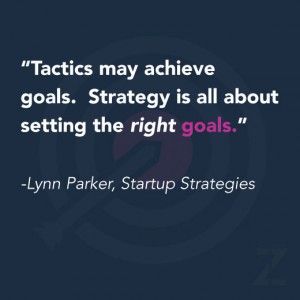The Difference Between Strategy & Tactics
Too often marketing teams and clients use the terms “strategy” and “tactics” interchangeably, as though they are the same thing. But that is far from the truth. While they share similar characteristics, they are very different when it comes to strategic planning for your next marketing, PR, or social media campaign. It is important to note that these terms, while extremely important and common in the marketing world, can come with a range of definitions, understandings, and meanings. From the very broad to the most detailed, you’ll hear it all, depending on who you ask. The purpose of this article is not to list out each and every possible viewpoint and definition of these two common terms. However, my goal is to provide you with a better understanding of just one of the ways in which you can view “strategy” and “tactics,” while also explaining their differences. To put it simply, strategy can be viewed as the “what,” whereas tactics can be viewed as the “how.” Ultimately, the two must work in tandem so your clients can achieve their goals.
Why Strategy is So Important
Business owners often rely on their intuition to make business decisions. While this informal knowledge is important in the decision-making process, it may not provide you with all the facts you need to achieve marketing results. Developing a good strategy is extremely important as it forces you to take a step back and look at the big picture, and avoid wasting time and resources on marketing tactics that may not make sense for your product or customer. For example, Brita implemented a new strategy for targeting their customers by placing their product in the water bottle aisle at grocery stores as opposed to with the appliances. This led to better exposure for the brand among their core audience and main competition. This type of strategic thinking leads to more revenue and market share for brands and organizations.
Establish Clear Goals

In order for a strategy to be effective, you must first establish clear and obtainable goals for which you can measure. By defining long-term goals, organizations are able to cut through the noise and determine the correct course of action to execute on achieving what they want. Using /Peter Drucker’s SMART criteria can be effective in outlining successful goals:
- Specific:
- Well-defined and clear to anyone that has a basic knowledge of the project.
- Measurable:
- Know if a goal is obtainable, how far away completion is, and by when it should be achieved.
- Attainable:
- Agreement with all the stakeholders what the goals should be.
- Realistic:
- Within the availability of resources, knowledge, and time.
- Time-related:
- Enough time to achieve the goal, but not too much to affect project performance.
Try to avoid being too vague. For example, “Build Brand Awareness” is not a good goal, whereas “Achieve 25% Increase in Social Engagement by 2017” is better as it fits each of the criteria listed above.
The Big Picture
“Tactics may achieve goals. Strategy is all about setting the right goals.” Lynn Parker, Startup Strategies
Now that goals are in place, a strategy to accomplish those goals can be developed. A strategy is the IDEA behind achieving the desired goals. Any number of strategies can be put into place to do so. Zion & Zion always takes into consideration the following before implementing a strategy:
- Market research and deep analytics to see how customers are currently accessing and using your services on and offline.
- Brand development, positioning and identity.
- A clear picture of the competition.
- Process that identifies strengths, weaknesses, competition and current industry environment. We use a proprietary process called PACE to identify any inconsistencies or opportunities.
Make sure to involve every department in the execution of your strategy, from the CEO to HR to front-line employees.
Besides focusing on the “what,” strategy is also about the “why.” Outlining philosophies and values help to better position the organization in front of their ideal customer.
The key is to remember that a good strategy will succeed organically through several forms of tactics and without the feeling of being forced.
“What If” Test
If you’re still wondering about the difference between strategy and tactics, try the “what-if” test. For example, “What if we found new uses for our product?” can lead to a strategy, whereas “What if we advertise on search engines through PPC?” contains a more specific action, therefore it is a tactic.
Where the Rubber Meets the Road
Translating strategy into tactics requires reviewing your operations in light of your strategy—understanding what resources you have available to you, and then allowing the strategy to direct how they are used. Tactics can include everything from TV, radio, direct mail, PR, social media, email marketing, PPC, SEO and so on. These actions communicate the brand image, inform target customers of your presence in the market, and begin to challenge their perceptions. Your tactics should directly support your strategic marketing plan. If your strategy involves finding new reasons customers should use your product, then your tactics could include TV advertising and a website dedicated to all the various uses of your product.
Here is a simple tactical plan that can help turn your strategy into a reality:
- Create the Experience
Discuss the branding, the packaging, and the process of providing product or service; operations, signage, customer service, employee buy-in, and so on. Basically, adjusting anything that affects how the customer will interact with the organization.
- Decide on Appropriate Marketing Channels
Choose what type of marketing mix will best reach your target audience, and position your brand appropriately in the marketplace. If it’s TV advertising, then what type? Broadcast or cable? Daytime or Evening?
- Measure
Make sure that any tactics put into place can be measured in some way so that it can be analyzed against the strategy and goals. If you are a retailer, then take door counts or look at sales revenue. If you are an online business, set up analytics to measure call to action and user experience.
Conclusion
An effective marketing strategy “connects the dots” (i.e. the tactics) into a more compelling marketing program. Ultimately WHAT you say and HOW you say it is important to understand before deciding WHERE to say it when creating a campaign. A great strategy identifies why your target customer makes certain purchasing decisions and what is important to them, and how your product or service fits into their life.
